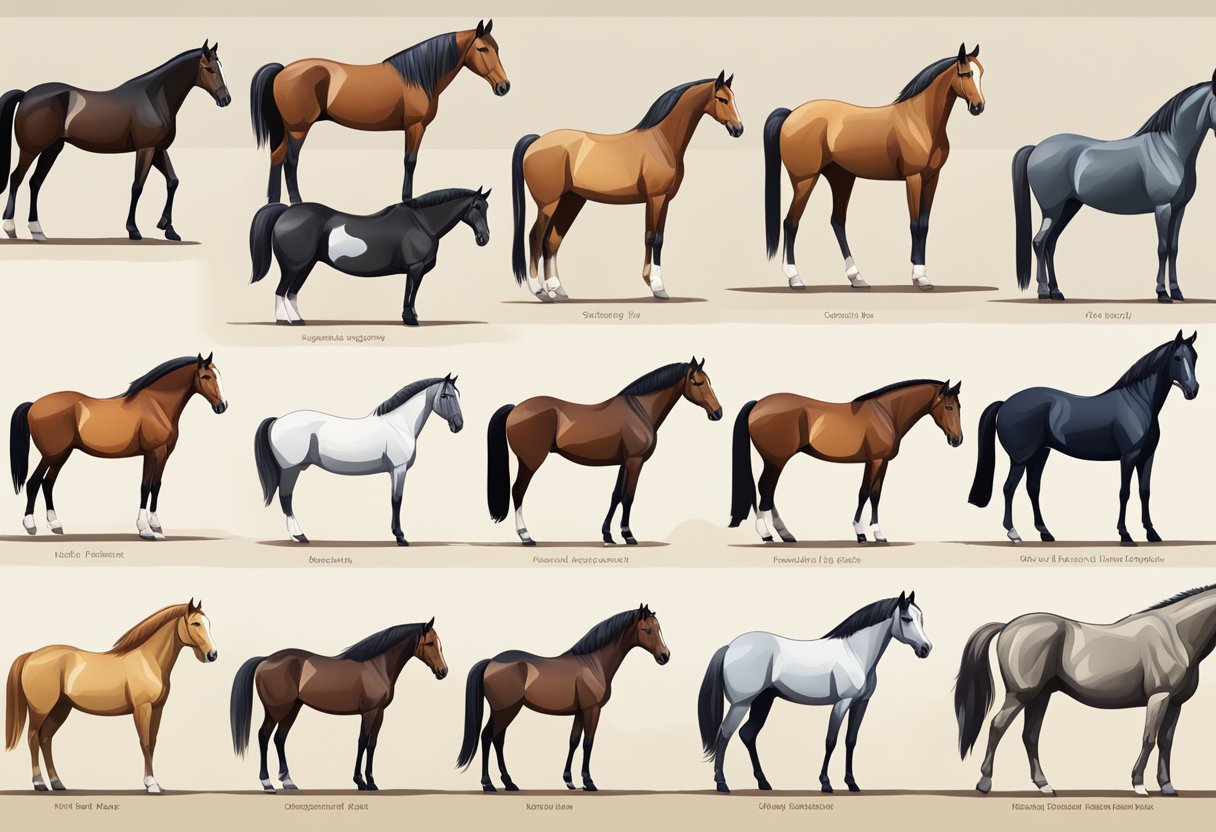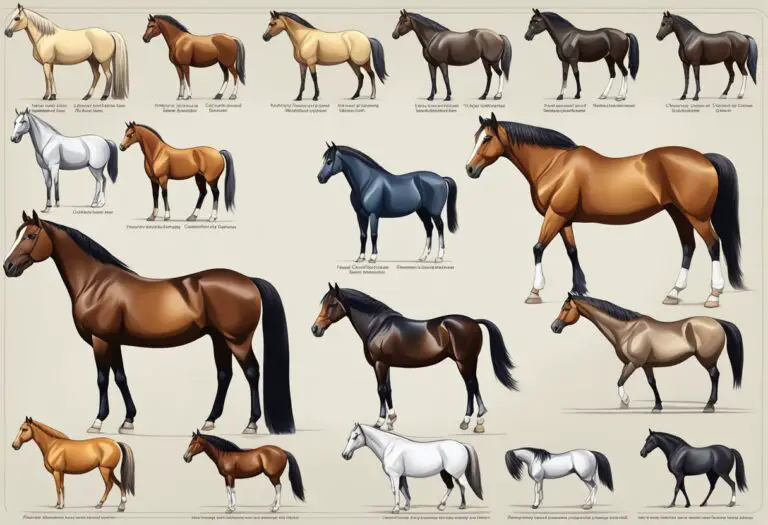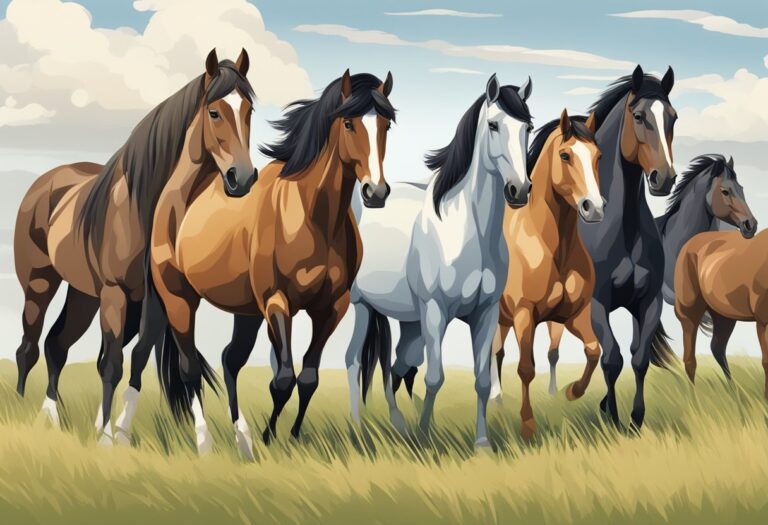What is the Average Height and Weight of Horse Breeds?
Horses come in a wide variety of breeds, each with its unique physical characteristics. One such characteristic is their height and weight, which can vary significantly depending on the breed. Understanding the average height and weight of different horse breeds is essential for horse owners and breeders alike.
The average height and weight of a horse breed can provide valuable information about their physical characteristics and potential uses. For example, larger breeds may be better suited for heavy work or riding, while smaller breeds may be better for activities such as racing or jumping. Additionally, understanding the average height and weight of a breed can help horse owners and breeders select appropriate feed and care for their animals.
Overview of Horse Breeds

Horses come in various breeds, each with its unique characteristics and physical attributes. The average height and weight of a horse breed depend on its category and standard. Understanding the different breed categories and standards can help you identify the right horse breed for your needs.
Breed Categories
Horse breeds are generally categorized based on their primary use, such as riding, racing, or work. Some common breed categories include:
- Draft Horses: These are large, muscular horses primarily used for heavy work, such as plowing fields or pulling carts. The average height of a draft horse is around 16 to 18 hands (64 to 72 inches), and their weight can range from 1,400 to 2,000 pounds.
- Riding Horses: These horses are bred for riding and can be further categorized into various subtypes, such as sport horses, pleasure horses, and gaited horses. The average height of a riding horse is around 14 to 17 hands (56 to 68 inches), and their weight can range from 900 to 1,400 pounds.
- Racing Horses: These horses are bred for speed and are primarily used for racing. The average height of a racing horse is around 15 to 17 hands (60 to 68 inches), and their weight can range from 800 to 1,200 pounds.
Breed Standards
Each horse breed has its unique set of standards that dictate their physical attributes, such as height, weight, and conformation. Breed standards are established by breed associations and are used to ensure the breed’s integrity and quality. Some examples of breed standards include:
- Thoroughbred: The Thoroughbred is a racing breed that typically stands around 16 hands (64 inches) tall and weighs between 1,000 and 1,200 pounds.
- Quarter Horse: The Quarter Horse is a versatile riding breed that typically stands around 15 hands (60 inches) tall and weighs between 1,000 and 1,200 pounds.
- Clydesdale: The Clydesdale is a draft breed that typically stands around 18 hands (72 inches) tall and weighs between 1,800 and 2,200 pounds.
In conclusion, understanding the different breed categories and standards can help you identify the right horse breed for your specific needs. Keep in mind that while average height and weight can provide a general idea of a breed’s physical attributes, individual horses may vary in size and conformation.
Determining Average Height and Weight

Determining the average height and weight of horse breeds can be a challenging task due to the variations in breed, age, gender, and other factors. However, there are some standard practices and methods that are commonly used to estimate the average height and weight of a particular breed.
Height Measurement Practices
The height of a horse is typically measured in hands, which is equivalent to four inches. To determine the height of a horse, the horse is usually measured from the ground to the highest point of its withers, which is the bony ridge between the horse’s shoulder blades. This measurement is taken using a measuring stick or a tape measure.
It is important to note that the height of a horse can vary depending on the age, gender, and breed of the horse. For example, some horse breeds are known to be taller than others, while male horses are usually taller than female horses.
Weight Estimation Methods
Estimating the weight of a horse is also a challenging task, as it requires taking into account various factors such as the breed, age, gender, and body condition of the horse. However, there are some methods that are commonly used to estimate the weight of a horse.
One of the most common methods is the use of a weight tape, which is a measuring tape that is specially designed for horses. The weight tape is wrapped around the horse’s girth, which is the area just behind the horse’s front legs, and the weight of the horse is estimated based on the reading on the tape.
Another method that is commonly used is the use of a formula that takes into account the horse’s heart girth measurement, which is the circumference of the horse’s chest just behind the front legs, and the horse’s length measurement, which is the distance from the point of the shoulder to the point of the buttock. This formula is then used to estimate the weight of the horse.
In conclusion, determining the average height and weight of horse breeds requires careful consideration of various factors, and the use of standard practices and methods. By following these practices and methods, it is possible to estimate the height and weight of a particular breed with a reasonable degree of accuracy.
Average Height of Horse Breeds

Horses come in different shapes and sizes, and their height varies depending on the breed. In this section, we will discuss the average height of horse breeds, categorized into three groups: Light Horse Breeds, Heavy Horse Breeds, and Pony Breeds.
Light Horse Breeds
Light Horse Breeds are typically used for riding, racing, and showing. They are known for their agility, speed, and endurance. The average height of Light Horse Breeds ranges from 14.2 to 16 hands (58 to 64 inches) at the withers, which is the highest point of the horse’s shoulders.
Some of the popular Light Horse Breeds and their average height include:
- Thoroughbred: 15.2 to 17 hands
- Arabian: 14.1 to 15.1 hands
- Quarter Horse: 14.3 to 16 hands
- Appaloosa: 14.2 to 16 hands
- Paint Horse: 14.2 to 16 hands
Heavy Horse Breeds
Heavy Horse Breeds, also known as Draft Horses, are bred for their strength and ability to pull heavy loads. They are typically taller and heavier than Light Horse Breeds. The average height of Heavy Horse Breeds ranges from 16 to 18 hands (64 to 72 inches) at the withers.
Some of the popular Heavy Horse Breeds and their average height include:
- Clydesdale: 16 to 18 hands
- Shire: 16.2 to 18.2 hands
- Percheron: 16 to 18 hands
- Belgian: 16 to 18 hands
- Suffolk Punch: 16.1 to 17.2 hands
Pony Breeds
Pony Breeds are smaller in size than Light Horse Breeds, and they are often used for children’s riding, driving, and showing. The average height of Pony Breeds ranges from 11.2 to 14.2 hands (46 to 58 inches) at the withers.
Some of the popular Pony Breeds and their average height include:
- Welsh Pony: 11 to 13.2 hands
- Shetland Pony: 7 to 11 hands
- Connemara Pony: 12.2 to 14.2 hands
- Haflinger: 13.2 to 15 hands
- Icelandic Horse: 13 to 14.2 hands
Knowing the average height of horse breeds can help you choose the right horse for your needs. It is important to note that these are only averages, and individual horses may vary in height.
Average Weight of Horse Breeds

Horses come in various sizes and breeds, each with unique characteristics and purposes. One of the most significant factors that differentiate horse breeds is their weight. Knowing the average weight of different horse breeds can help horse owners and enthusiasts understand their needs better and provide appropriate care.
Light Horse Breed Weights
Light horse breeds are typically used for riding, racing, and other athletic activities. These breeds are known for their agility and speed, and they usually weigh between 900 and 1,400 pounds. Here are some of the popular light horse breeds and their average weight:
- Thoroughbred: 1,000 pounds
- Arabian: 1,000 pounds
- Quarter Horse: 1,100 pounds
- Morgan: 1,000 pounds
- Appaloosa: 1,100 pounds
Heavy Horse Breed Weights
Heavy horse breeds, also known as draft horses, are bred for their strength and ability to perform heavy work. These breeds are usually larger and heavier than light horse breeds, weighing between 1,400 and 2,000 pounds. Here are some of the popular heavy horse breeds and their average weight:
- Clydesdale: 1,800 pounds
- Shire: 1,800 pounds
- Belgian: 1,800 pounds
- Percheron: 1,900 pounds
- Suffolk Punch: 1,800 pounds
Pony Breed Weights
Ponies are smaller than horses and are often used for riding and driving. They usually weigh between 400 and 900 pounds, making them suitable for children and smaller adults. Here are some of the popular pony breeds and their average weight:
- Shetland Pony: 400 pounds
- Welsh Pony: 500 pounds
- Connemara Pony: 700 pounds
- Icelandic Pony: 700 pounds
- Haflinger: 800 pounds
In conclusion, understanding the average weight of different horse breeds is essential for providing appropriate care and meeting their specific needs. Horse owners and enthusiasts should also consider other factors such as height, body condition, and age when determining the appropriate weight for their horses.
Factors Influencing Height and Weight

In order to understand the average height and weight of horse breeds, it is important to consider the various factors that influence these measurements. Some of the main factors include genetics, nutrition, and age and growth patterns.
Genetics
Genetics play a significant role in determining the height and weight of a horse. Different breeds have different genetic predispositions, which can result in varying sizes and shapes. For example, draft horses such as Clydesdales and Shires are typically much larger and heavier than Arabian horses, which are smaller and more slender.
Nutrition
Nutrition is also a critical factor in determining the height and weight of horses. A horse’s diet can impact its growth rate and overall size. Horses that are fed a balanced diet with the appropriate nutrients are more likely to reach their full potential in terms of height and weight. On the other hand, horses that are malnourished or fed an imbalanced diet may not reach their full potential and may be smaller in size.
Age and Growth Patterns
Age and growth patterns are also important factors to consider when looking at the average height and weight of horse breeds. Horses typically reach their full height by the age of four, but may continue to fill out and gain weight until they are six or seven years old. Additionally, the rate of growth can vary depending on the breed and individual horse. For example, some breeds may experience a growth spurt early on and then plateau, while others may have a slower, more steady growth pattern.
Overall, understanding the various factors that influence the height and weight of horse breeds can help horse owners and enthusiasts better understand these majestic animals. By providing proper nutrition and care, horses can reach their full potential in terms of size and stature.
Breed-Specific Height and Weight Charts

When it comes to determining the average height and weight of a horse, it’s important to consider the breed. Each breed has its own unique characteristics and physical attributes that determine its size and weight.
Here are some breed-specific height and weight charts to give you an idea of what to expect:
Thoroughbred
- Height: 15-17 hands (60-68 inches)
- Weight: 900-1200 pounds
Quarter Horse
- Height: 14-16 hands (56-64 inches)
- Weight: 950-1200 pounds
Arabian
- Height: 14-15 hands (56-60 inches)
- Weight: 800-1000 pounds
Clydesdale
- Height: 16-18 hands (64-72 inches)
- Weight: 1600-2400 pounds
Shetland Pony
- Height: 7-11 hands (28-44 inches)
- Weight: 400-450 pounds
It’s important to note that these are just averages and individual horses may fall outside of these ranges. Additionally, factors such as age, gender, and overall health can also affect a horse’s height and weight.
By understanding breed-specific height and weight charts, horse owners and enthusiasts can better understand the physical characteristics of their horses and make informed decisions regarding their care and training.
Implications of Height and Weight on Horse Care

The height and weight of a horse can have significant implications on its care. Horse owners and caretakers need to be aware of these implications to ensure the health and well-being of their horses.
One of the most important implications of height and weight is the amount of feed and water a horse requires. Larger horses generally require more food and water than smaller horses. Horse owners should adjust their feeding and watering routines accordingly to ensure that their horses are receiving the proper amount of nutrition.
Another implication of height and weight is the type of equipment that should be used. Larger horses may require larger saddles, bridles, and other equipment. It is important to use properly fitting equipment to prevent discomfort and injury to the horse.
Horse owners should also be aware of the potential for joint problems in larger horses. The added weight and stress on their joints can lead to issues such as arthritis. Regular exercise and proper nutrition can help prevent these problems.
In addition, larger horses may be more difficult to handle and require more experienced handlers. It is important for horse owners to assess their own abilities and experience level before purchasing a larger horse.
Overall, the height and weight of a horse should be carefully considered when planning its care. Proper nutrition, equipment, and handling can help ensure that the horse remains healthy and happy.
Comparative Analysis with Other Equines

When it comes to comparing horse breeds with other equines, there are a few key differences to consider. For example, donkeys and mules are typically shorter and stockier than horses, with a more compact build. Additionally, ponies are smaller than horses, with a maximum height of 14.2 hands.
In terms of weight, horses are generally heavier than donkeys and mules, but lighter than draft horses such as Clydesdales and Percherons. While the average horse weighs between 900 and 2,000 pounds, draft horses can weigh up to 2,500 pounds or more.
When it comes to height, the tallest equine breed is the Shire horse, which can reach up to 18 hands. On the other hand, the Falabella, a miniature horse breed, is only around 30 inches tall at the shoulder.
Overall, while there are certainly differences between horse breeds and other equines, each type has its own unique characteristics and strengths. By understanding these differences, horse owners and enthusiasts can better appreciate the diversity and beauty of the equine world.







